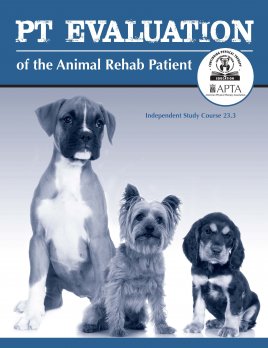
PT Evaluation of the Animal Rehab Patient
| Online Only | |
|---|---|
| APTA Orthopedics Member | $35
$25
|
| Non-APTA Orthopedics Member | $50
$40
|
Note: CEUs are not offered for this course.
Course Description
This 2-monograph series presents animal rehabilitation for the canine and equine populations. The importance of using clinical reasoning skills to guide the assessment for each animal patient is emphasized. Also, a team approach to rehabilitation of the animal patient is highlighted along with specific treatment intervention strategies. A companion monograph covers recognition of the clinical signs of disease in humans and animals that are associated with zoonotic diseases. Implementation of proper infection control and intervention is a focus. Cases studies are provided for each monograph.
Course Overview
Course Format: Online
Course Objectives
- Understand the importance of obtaining a veterinary referral and diagnosis prior to assessing and treating the animal patient.
- Recognize the importance of a team approach to rehabilitation of the animal patient.
- Understand the importance of performing a review of systems and general health assessment prior to physical therapy evaluation or treatment.
- Be able to identify conditions that may alter the course of physical therapy treatment, affect the prognosis, or require referral for further veterinary evaluation.
- Understand the importance of using clinical reasoning skills to guide the assessment and treatment.
- Formulate a thorough plan of assessing the equine patient, formulating a problem list, and initiating a treatment plan based on good clinical reasoning skills.
- Understand the definition of zoonoses and their impact in animal rehabilitation.
- Recognize the clinical signs associated with the most common zoonotic diseases.
- Distinguish among bite and scratch zoonoses, enteric zoonoses, exudate-associated zoonoses, respiratory zoonoses, urogenital zoonoses, and vector-associated zoonoses.
- Understand and be able to apply prevention strategies to lessen the risk of acquiring a zoonotic infection.
Topics and Authors
- Evaluation of the Canine Rehabilitation Patient
Lisa Bedenbaugh, PT, CCRP, Evelyn Orenbuch, DVM, CAVCA, CCRT - Zoonosis and Animal Rehabilitation
Michael R. Lappin, DVM, PhD, DACVIM
Add To Cart
Which version of the course would you like to purchase?
Members Only
You need to be a member to buy this course.
Join today to enjoy exclusive deals and prices on all courses.
Join Now